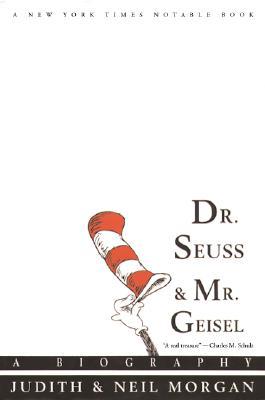I don't often read biography. Prior to picking up Dr. Seuss & Mr. Geisel by Judith & Neil Morgan for last month's book club, I think the last time I read a biography was when I was doing my undergrad (almost 10 years ago now). Usually this just isn't a genre that catches my eye at the library. I'm a prolific reader of fiction, and non-fiction has to be really, truly special in order to get read. Now I probably should be striving to advance variety in my interests and be an eclectic reader of all the things, but dammit, I like what I like.
Regardless, here is a short review of the aforementioned Seuss biography.
When we pulled biography as our theme for July's book club, my initial desire was to read a book about my favorite silent film actor, Buster Keaton. However, the biography at the library was a coffee table book, and I had rode my bike that day, so the massive, picture-laden tome was out of the question. Instead I put in an ILL for a biography on my favorite children's authour, Dr. Seuss.
Written about five years after his death in 1991, Dr. Seuss & Mr. Geisel presents an easy-to-understand, chronological view of the life of the highly productive and much loved children's book authour. There are about five pages of photographs included with the book, which are also ordered chronologically and show the development of Ted Geisel from imaginative boy to the man who captured all of our imaginations.
As with many people who lived across the span of the 20th century, what is nearly as interesting as the biographical aspects of Ted's life are the glimpses into the society in which he grew up and lived. As a descendent of German immigrants, we see how racism and bullying permeated American society during the World Wars and impacted Ted's personality. The rise and fall of prohibition is also well-documented here, through the impact it held for Ted's father and grandfather, who worked as brewers. Even the advent of various technologies, from typewriter to electric typewriter to computer, occurred during Ted's lifetime as held sway over his works. The two Morgans do an excellent job of demonstrating not only the development of Ted as artist and writer but also just how much changed in America and around the world over the course of Ted's lifetime.
The only place I hold issue with this biography is in its tendancy to mince words and be a bit euphemistic when it comes to Ted's failings and shortcomings. The big one being that the book does not explicitly say that he began a relationship with Audrey Dimond while they were both still married to other people, and even which contributed to the suicide of his first wife, Helen Palmer. This is simply implied. I also didn't like how Helen's suicide was treated as some sort of noble act, as opposed to it being the death of a woman who was not only heartbroken but who had suffered with a painful ailment for over ten years. While I understand that it is a biography about Ted, I felt it was insensitive to treat Helen's death as simply a means to progress and advance Ted's life and his relationship with Audrey.
So in conclusion, I'm not sure how to rate this book as far as biographies go due to a lack of benchmarks in my own reading experience. I very much enjoyed the book overall, and it's merits as a highly-readable and accessible biography outweigh some of the issues I took with the authours being overly tactful. Overall, I would recommend this biography for any Seuss fan who wants to find out a bit more about the man and his beloved characters which have entertained both children and adults for several generations.

No comments:
Post a Comment